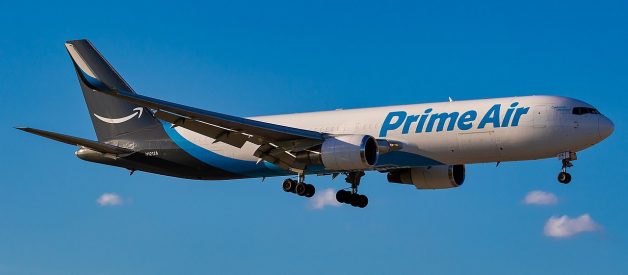 The wreckage of Atlas Air flight 3591 lies partially submerged in Trinity Bay near Houston. (Business Insider)
The wreckage of Atlas Air flight 3591 lies partially submerged in Trinity Bay near Houston. (Business Insider)
On the 23rd of February 2019, a Boeing 767 transporting cargo for Amazon suddenly dived into Trinity Bay while on approach to Houston, Texas, killing all three people on board. From the putrid estuary, investigators pulled the jet?s two black boxes, which together revealed the perplexing story of the last moments of Atlas Air flight 3591. It all began with a bumped switch, a tiny action that ultimately led to catastrophe when the disoriented first officer panicked and flew his plane into the ground. The sequence of events in the cockpit defied comprehension. How could a trained pilot make such a fundamental error? It was in their attempts to answer this question that investigators found the real cause of the accident. Beneath the surface of the first officer?s training record, they found a long history of failed examinations, terrible airmanship, and difficulties performing basic procedures. One instructor said that he was one of the worst pilots he had ever trained. And after all of this, he was hired anyway ? due to inadequate hiring practices, a deliberate act of deception, and an FAA program that wasn?t implemented in time to stop it.
**
Whenever you order a product from Amazon.com, your item is shipped through a complex transportation network designed to move inventory from an Amazon distribution center to your doorstep as quickly as possible. Perhaps the most critical link in this underappreciated wonder of the world is Amazon?s fleet of cargo planes, which crisscross the skies above our heads day in and day out, transporting the goods that fuel America?s modern consumer society.
In 2015, Amazon decided to found its own cargo airline in order to simplify this process. The result was Prime Air, now known as Amazon Air. Although most Amazon cargo is still shipped by other carriers, Amazon Air has been expanding rapidly in an attempt to corner its share of this market. The airline doesn?t own any aircraft; instead, it leases its 51 Boeing 737s and 767s from other operators, mostly Air Transport International and Atlas Air, two of the largest cargo carriers in the United States. These aircraft are painted in Amazon livery and fly Amazon cargo, but the pilots work for the individual operators, who are also responsible for flight safety.
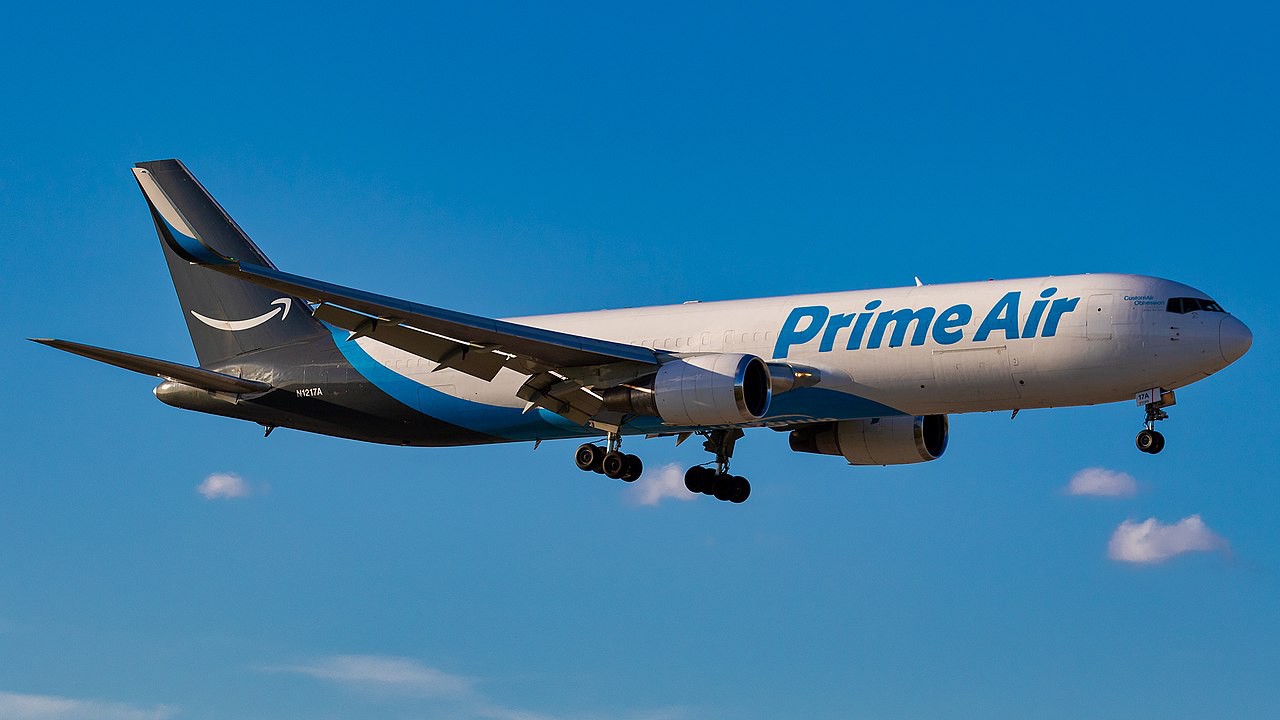 N1217A, the Boeing 767 involved in the accident. (Nathan Coats)
N1217A, the Boeing 767 involved in the accident. (Nathan Coats)
It was one of Amazon Air?s Boeing 767s, owned by Atlas Air, that operated a regularly scheduled flight from Miami, Florida to Houston, Texas on the 23rd of February 2019. The wide body jet, which sported Amazon livery, was hauling a cargo of Amazon packages along with mail on behalf of the United States Postal Service. In command of the jet were two pilots: 60-year-old Captain Ricky Blakely, and 44-year-old First Officer Conrad Jules Aska; a third pilot, Captain Sean Archuleta of the regional carrier Mesa Airlines, rode along in the cockpit jumpseat. Archuleta had just landed his dream job flying for United Airlines and was headed to Houston to spend a week with his family before starting at the new position.
A little after 12:30 p.m., Atlas Air flight 3591 was descending into Houston George Bush Intercontinental Airport amid partial overcast and scattered thunderstorms. Other than some light turbulence, everything seemed normal, and the pilots joked among themselves as they navigated around the weather. While First Officer Aska flew the plane, Captain Blakely handled the radio calls and monitored the instruments.
At 12:36, the Houston approach controller contacted flight 3591, which was descending toward 6,000 feet, and said, ?Giant thirty five ninety one, descend and maintain three thousand ? hustle all the way down, I?m gonna get you west of this weather and northbound for a base leg.? In order to comply with the request to ?hustle,? First Officer Aska extended the speed brakes, which reduce the lift generated by the wings in order to help the plane descend faster. In accordance with company procedures, he kept his left hand on the lever so that he wouldn?t forget to retract the speed brakes after reaching 3,000 feet.
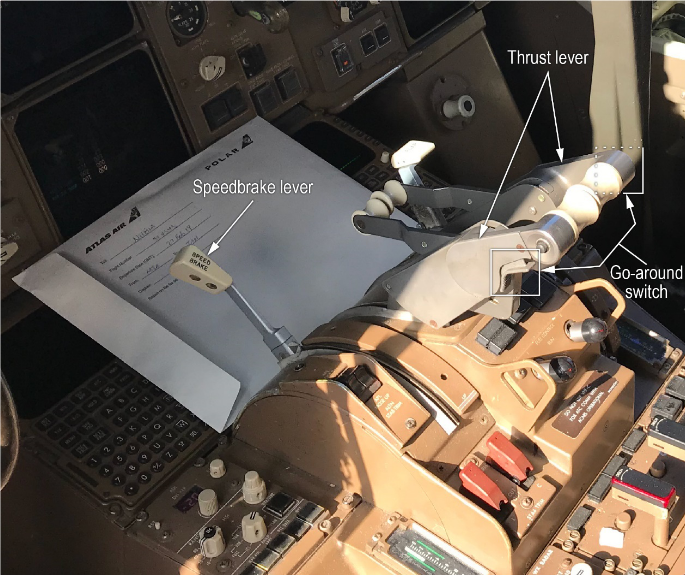 The location of the speed brake lever on the Boeing 767. (NTSB)
The location of the speed brake lever on the Boeing 767. (NTSB)
The speed brake lever is on the captain?s side of the center pedestal next to the throttle levers. When a first officer reaches across the pedestal to hold the speed brake lever, his or her wrist passes right underneath the back side of the throttle levers, making contact between them possible if the engines are set to low power, especially if the first officer is wearing a watch. Coincidentally, this position puts the first officer?s wrist in just the right position to bump into the left takeoff/go-around, or TOGA, switch. The TOGA switches are a pair of buttons on the bottom side of each thrust lever, designed to be pushed by a pilot?s thumb while holding the throttles. When pressed, either button will place the flight computer in go-around mode, automatically increasing engine thrust and pitching the nose up to climb. Normally, the TOGA switches are used to quickly abort an approach at low altitude if something goes wrong. But on flight 3591, due to the cockpit ergonomics, First Officer Aska managed to press one accidentally: while he was holding on to the speed brake lever, a bout of turbulence jolted his wrist upward and into the left TOGA switch, placing the airplane in go-around mode without anyone realizing.
 How the go-around switches can be accidentally bumped while holding the speed brake lever. (NTSB)
How the go-around switches can be accidentally bumped while holding the speed brake lever. (NTSB)
Although all the mode indicators on the pilots? displays suddenly changed to ?GA? and thrust began to increase, neither pilot initially noticed that anything was wrong. Keeping an eye on mode indications and other instruments was the job of the pilot not flying the plane, which in this case was Captain Blakely; however, at that moment he was busy programming approach information into the flight computer and was not looking at his display. The shift in the airplane?s energy state also did not strike First Officer Aska as unusual because he was expecting a slight increase in power and pitch up to occur automatically when the plane reached 3,000 feet, although they were in fact nowhere near this altitude. As the engines began to accelerate to go around power and the nose started to pitch up toward four degrees, both pilots remained oblivious to the mode change that had occurred.
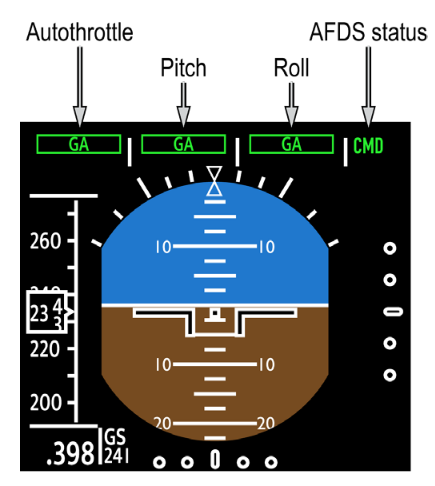 Mode change indications that would have been visible to the pilots when go-around mode activated. (NTSB)
Mode change indications that would have been visible to the pilots when go-around mode activated. (NTSB)
But what First Officer Aska did notice as the plane transitioned into a climb were the physical sensations induced by the change of trajectory. Humans rely on three sensory systems to determine the vector of our motion through space: the visual system (our eyes); and the vestibular and the somatosensory systems, located in the inner ear, which detect the pull of gravity. When go-around mode activated on flight 3591, the plane was enveloped in dense cloud, providing no visual reference points outside the cockpit. This meant that Aska?s brain relied on the vestibular and somatosensory systems to understand the physical orientation of his body during the maneuver. However, both of these organs actually measure the direction of the gravito-inertial force, or GIF vector, which includes both gravity and the force of acceleration. When the human body accelerates rapidly, the GIF vector swings aft as the acceleration presses us back into our seats, but without a visual reference to determine our orientation, the brain is not capable of distinguishing between an aft shift in the GIF vector caused by acceleration and a shift in the position of the body relative to gravity. This gives rise to a phenomenon known as somatogravic illusion: a sensation of leaning backwards when one is actually accelerating. As flight 3591 accelerated for the go-around, First Officer Aska experienced a somatogravic illusion that tricked him into believing that the plane was pitching up excessively. Seven seconds after the activation of go-around mode, the illusion became so intense that Aska instinctively began to push the nose down to counter the steep pitch up which he believed existed.
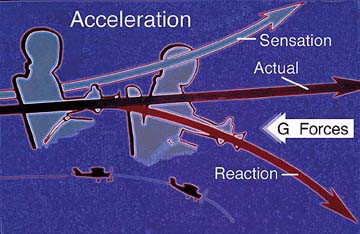 How somatogravic illusion occurs. (Piper Owner Society)
How somatogravic illusion occurs. (Piper Owner Society)
Had Aska looked at his attitude indicator, it would have been obvious that their pitch was completely normal, but he did not. In a panicked intonation he exclaimed, ?Oh!!? and retracted the speed brakes. Captain Blakely still had his nose in the computer and didn?t notice that anything was wrong for several seconds. As he pushed the plane farther into a dive, Aska shouted, ?Whoa!? followed by a desperate exhortation, ?Where?s my speed, my speed!?? Believing that the plane was in a nose-high position and in danger of stalling, he might have been confused as to why his speed was increasing instead of decreasing. Within seconds, his sustained inputs on the control column disconnected the autopilot and pitched the plane over to nearly 50 degrees nose down, sending the 767 diving toward the ground from 6,000 feet. The sudden transition to a dive pulled the pilots up out of their seats and sent the GIF vector swinging up over their heads, creating an extremely disorienting sensation of tumbling backwards. Only now did Captain Blakely ? himself extremely disoriented by the sudden maneuver ? look up and try to figure out what was going on. He immediately looked at his attitude indicator, saw that they were in a dive, and pulled back on his control column to climb. But he never ensured a positive transfer of control, and as he tried desperately to pull up, First Officer Aska continued to push the nose down ? the pilots were fighting each other!
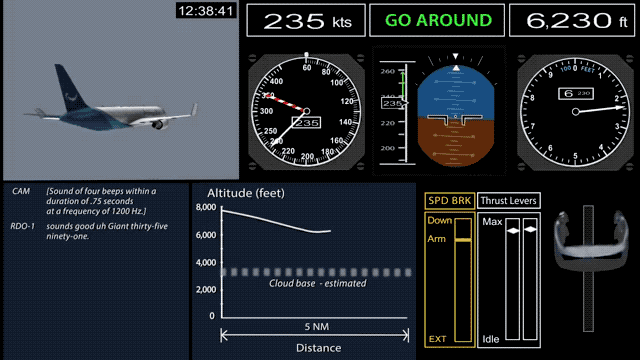 An NTSB animation of the dive, with the CVR transcript, performance data, and instrument indications. (NTSB)
An NTSB animation of the dive, with the CVR transcript, performance data, and instrument indications. (NTSB)
As the plane plunged from the sky, a series of bangs and thumps filled the cockpit as unsecured objects flew in every direction. ?We?re stalling! Stall!? Aska exclaimed, although there was not a single indication that this was the case, except for his own disorientation. ?Oh lord have mercy myself!? he screamed. ?Lord have mercy!? Turning to his captain, he pleaded, ?Ricky!?
?What?s going on?? Captain Blakely asked,
?Lord ? Ricky!? Aska screamed again.
?What?s going on?? shouted Sean Archuleta, the jump seat captain.
?Rick ? ?
The sound of a loud continuous clacker filled the cockpit as the plane exceeded its maximum operating speed. From the back of the cockpit, Archuleta yelled, ?Pull up!?
At that moment, the plane broke through the clouds, suddenly providing a visual reference for First Officer Aska. The shout of ?pull up? and the appearance of the ground finally dispelled the illusion and he hauled backward on his control column with all his might. But it was obvious that it was too late.
?Oh god!? someone yelled.
?Lord Jesus you have my soul!? Aska screamed. Two seconds later, still pulling out of its dive, the Boeing 767 slammed into the shallow water of Trinity Bay at more than 740 kilometers per hour (400 knots), obliterating the airplane and throwing a column of water high into the air. The plane hit the water with such force that the shattered debris was driven up to three meters into the muddy bottom, leaving only light debris and pieces of fuselage skin floating like a white streak on the surface.
 A CCTV camera on a nearby building captured the final seconds of Atlas Air flight 3591. (Houston Chronicle)
A CCTV camera on a nearby building captured the final seconds of Atlas Air flight 3591. (Houston Chronicle)
Upon receiving calls from witnesses who saw the plane go down, emergency services rushed to the scene to search for survivors. Instead, they were confronted by a grim tableau of destruction. The wide body jet had been reduced to pulverized wreckage and it was obvious that all three people on board had died instantly on impact. From that point on, the response to the crash would fall to the coroner and the National Transportation Safety Board.
An NTSB go-team arrived at the crash site within hours and set about searching for the black boxes. Amid the mud and tangled debris, the flight recorders were not easy to find; it took more than a week for divers to locate the bright orange boxes on the bottom of Trinity Bay and send them to Washington D.C. for analysis.
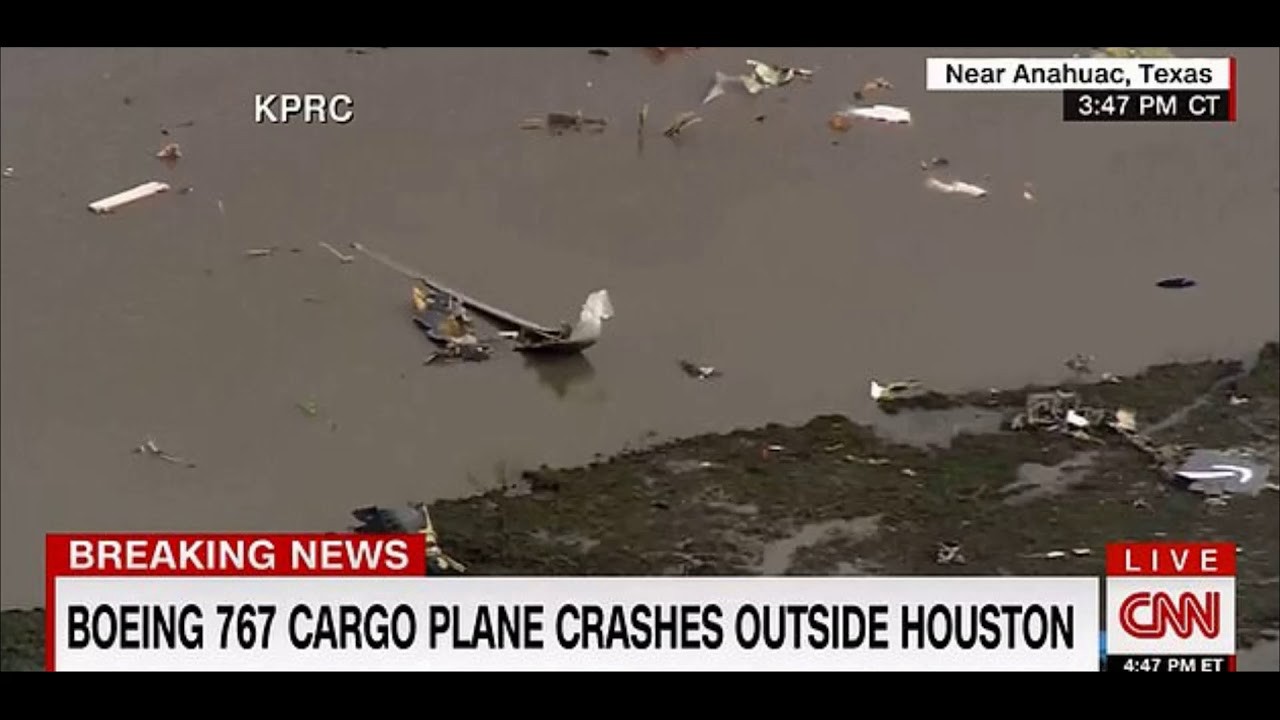 A still from aerial news footage of the site shortly after the crash. (CNN)
A still from aerial news footage of the site shortly after the crash. (CNN)
After careful review of the flight data recorder and cockpit voice recorder, the NTSB developed a basic understanding of the sequence of events. As flight 3591 descended into Houston, First Officer Aska accidentally bumped the left TOGA switch with his wrist while holding the speed brake lever. The resulting acceleration triggered a somatogravic illusion which tricked him into putting the plane into a dive from which the pilots failed to recover. However, this left two glaring questions: why didn?t the captain take action in time to save the plane, and why did the first officer succumb to a common sensory illusion that pilots are trained to avoid by trusting their instruments?
The first question was simple enough for investigators to answer; all they had to do was put themselves in Captain Blakely?s shoes. He had been programming the flight computer and was absorbed in this task until 10 seconds after the activation of go-around mode. He was only startled out of this focused state when the plane pitched over into a dive. In this extremely disorienting situation, he had to figure out the attitude of the airplane, why the plane was in that attitude, what the first officer was doing, and what he needed to do to recover. The cues he got were confusing: the attitude indicator showed the plane in a dive, First Officer Aska screamed that they were stalling, and his internal sense of balance had been thrown completely out of whack. In this environment, it was no surprise that he forgot to explicitly announce that he had control. Without a clear signal that Blakely was taking over, Aska continued to hold the plane in a dive, splitting their control inputs until it was too late to recover.
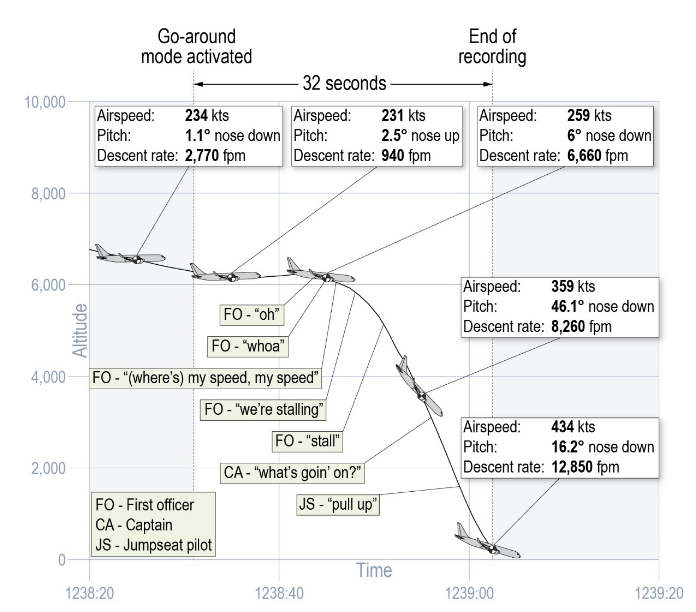 Timeline of flight 3591?s fatal dive. (NTSB)
Timeline of flight 3591?s fatal dive. (NTSB)
It was much harder for investigators to understand why First Officer Aska ignored all of his instruments and pitched the plane down in the first place. The somatogravic illusion is well known to pilots and the symptoms should be easy to recognize. Pilots are taught to rely on their instruments specifically to avoid instinctive reactions to unreliable vestibular cues. A crash due to a somatogravic illusion simply shouldn?t have happened. To figure out why, investigators sought to understand Conrad Jules Aska as both a pilot and a person.
Aska was born in the tiny Caribbean nation of Antigua and Barbuda in 1974. He got his start as a pilot in 2008 at Air Turks and Caicos (now known as InterCaribbean), a regional airline serving the Caribbean?s many scattered islands, where he flew the Embraer EMB-120 Brasilia. Over the next 11 years, he worked for no fewer than seven different airlines. After leaving Air Turks and Caicos, in 2011 he was hired by CommutAir to fly the de Havilland Canada DHC-8, but resigned before completing the training course, citing lack of progress. In 2012 he began training for the Bombardier CRJ-200 with Air Wisconsin, but again, he did not complete the course; records showed he resigned for ?personal reasons.? He eventually returned to the EMB-120, which he flew for two years at Charter Air Transport. Then in 2014, he switched to Trans State Airlines, where he flew the Embraer ERJ-145, but he failed a line check later that year and resigned, again citing ?personal reasons.? Between 2015 and 2017 he flew for Mesa Airlines, this time on the ERJ-175; he attempted to upgrade to captain but was unsuccessful. Finally, in July 2017, he was hired by Atlas Air to fly Boeing 767 cargo planes, which he did right up until the crash. At first glance, the sheer number of different airlines on his resume and the unusually high number of resignations already raised some eyebrows. This turned out to be just the tip of the iceberg.
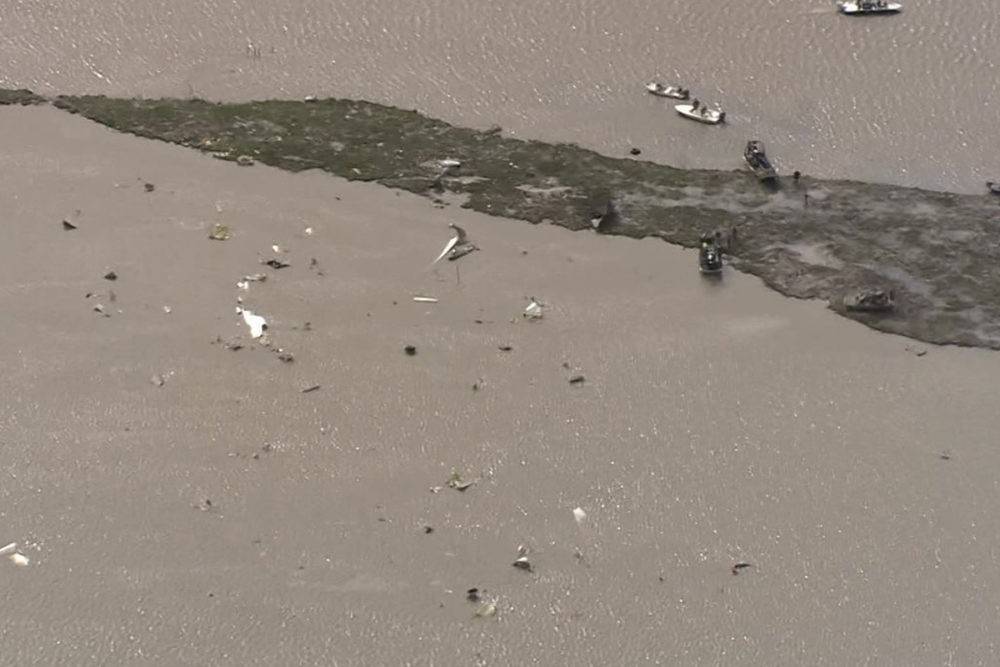 Aerial view of the wreckage site. (Houston Public Media)
Aerial view of the wreckage site. (Houston Public Media)
Scrutiny of Aska?s records from all of these airlines revealed numerous training difficulties. First he failed to complete training at two different airlines. Then at Trans State Airlines, he failed an oral exam on the ERJ-145, then failed a check ride (a graded flight with an instructor) in May 2014, followed by a failed line check (a regular line flight, but graded by an instructor) in August, after which he resigned. In May 2017 at Mesa Airlines he failed to upgrade to captain. In September 2017, at Atlas Air, he failed his Boeing 767 type rating exam ?due to unsatisfactory performance in crew resource management, threat and error management, non-precision approaches, steep turns, and judgment.? After most of these failures, he went to remedial training and eventually passed.
To learn more about why he failed so many times, the NTSB interviewed the examiners and check airmen who had graded him. The Atlas Air check airman who failed First Officer Aska on his Boeing 767 type rating examination told the NTSB that Aska lacked situational awareness, ?overcontrolled the airplane,? was ?very nervous,? ?did not work well with the other pilot,? and forgot to perform emergency checklists. Aska was constantly behind his airplane and its actions would catch him by surprise. When confronted with something unexpected, he would panic and start pushing the wrong buttons. The check airman worried that the failure was so traumatic that Aska would not be able to ?mentally recover.?
 Crews wade in the shallow water, looking for important debris. (Business Insider)
Crews wade in the shallow water, looking for important debris. (Business Insider)
Next, the NTSB interviewed the check airmen who had trained First Officer Aska at his previous employer, Mesa Airlines. According to three instructors at that airline, Aska had no trouble with rote tasks; however, they confirmed that when faced with an unexpected event, he would start pressing random buttons in order to feel like he was doing something. His ability to fly the plane manually was weak, but he wasn?t any better with the automation, because he struggled to use the flight management computer. Like the check airman at Atlas, they stated that Aska had poor situational awareness and didn?t understand what his airplane was doing. One Mesa Airlines check airman said that Aska?s piloting ability was among the worst he had ever seen. Another told the NTSB that despite all the evidence to the contrary, Aska didn?t think he was a bad pilot, or at least he was unwilling to admit it. Every time he failed he came up with an excuse, blaming his poor performance on the hotel where he spent the night, his simulator partner, or the instructor. He had no idea that he lacked basic airmanship skills, refused to accept feedback, and didn?t understand why he couldn?t upgrade to captain. NTSB investigators were left utterly astounded. Naturally, they had encountered some poor pilots over the years ? but none quite so bad as Conrad Jules Aska. It seemed obvious that, for his own safety and the safety of the public, Aska should have been forced to pursue a different career. So why did he keep getting hired?
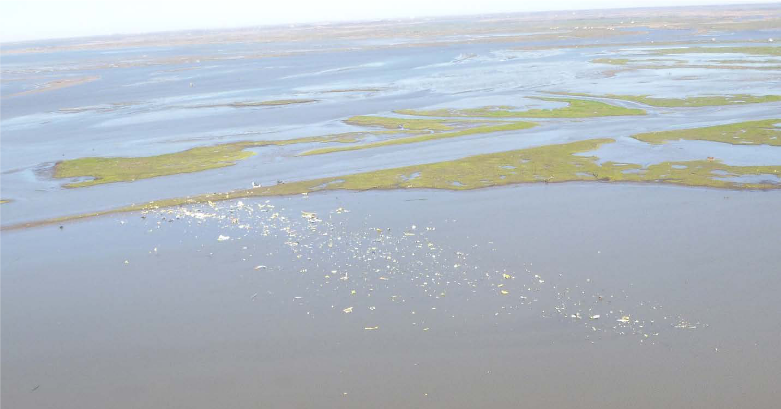 Aerial overview of the entire crash site at low tide. (NTSB)
Aerial overview of the entire crash site at low tide. (NTSB)
A review of hiring records and interviews with Atlas Air?s human resources department revealed the shocking truth: Aska had gotten the position at Atlas Air because he lied about his past. When asked to provide his work history to Atlas Air, he neglected to mention his failure to complete training at Commutair and Air Wisconsin, and when asked what he was doing during these time periods, he told Atlas that he was working as a freelance real estate agent, attending university, or on furlough. The NTSB also found that Aska had lied in the exact same manner to Trans State Airlines three years earlier. Atlas?s director of human resources admitted to investigators that ?it?s hard to catch someone who?s deliberately trying to deceive you.? In fact, no mechanism existed that would have allowed either airline to discover the lie. Although the Pilot Records Improvement Act of 1996, known as PRIA, had set up a system whereby airlines could request documents from an applicant?s previous employers, the system relied on applicants faithfully disclosing all of their work history. Because Aska didn?t tell Atlas Air that he worked for CommutAir and Air Wisconsin, they didn?t know that they needed to request documents from those companies.
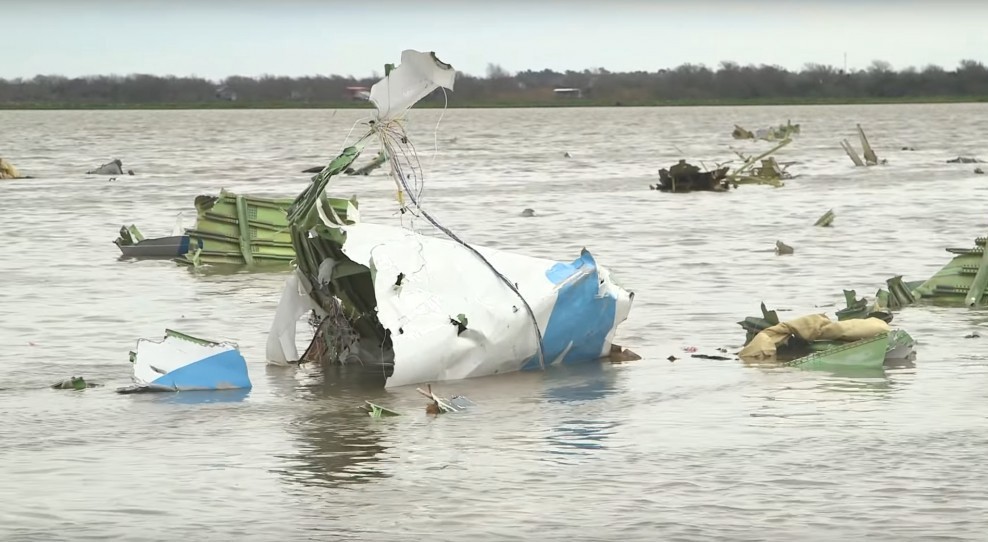 A piece of mangled wreckage included part of the Prime Air livery. (NTSB)
A piece of mangled wreckage included part of the Prime Air livery. (NTSB)
On top of this, Atlas Air?s background check on Aska also missed his failure to upgrade to captain. Although the documentation received from Mesa Airlines mentioned this failure nine times, it used vague language, noting that Aska ?returned to first officer? rather than explicitly stating that his attempt to upgrade had been rejected. Neither the HR director nor the ?designated agent? that Atlas paid to acquire and review the documents was a subject matter expert on pilot training, and neither noticed the oblique references to this failure sprinkled throughout Aska?s Mesa Airlines training records. As was standard practice, none of the documents contained details about why he failed the examinations or check rides. As a result of these omissions, the hiring committee saw a pilot who had one or two failures on his record but had much more experience with turbine aircraft than the average applicant, and they rated him as ?highly recommended? for employment. Everyone involved in the process told the NTSB that if they had known about Aska?s failure to complete training at two airlines and his subsequent failure to upgrade to captain, they most likely would not have hired him.
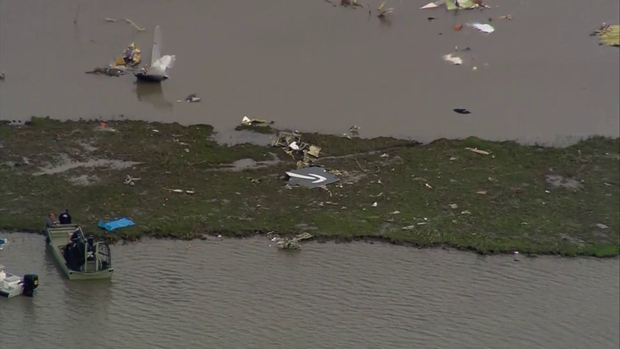 One large piece of the vertical stabilizer included half of Amazon?s ubiquitous smile logo. (WDEF)
One large piece of the vertical stabilizer included half of Amazon?s ubiquitous smile logo. (WDEF)
Another question remained: after Aska was hired, why didn?t Atlas Air identify his fundamental deficiencies as a pilot? Atlas Air had a so-called ?Pilot Watch Program,? or PWP, in which at-risk pilots were closely monitored and received extra training, but First Officer Aska was never placed in it. The fleet captain, who was responsible for overseeing the PWP, had not recognized an aptitude problem as being the root cause of Aska?s difficulties in training. Aska?s initial Boeing 767 training had been interrupted for two weeks due to a hurricane, and he failed the examination three days after returning to finish the course. The fleet captain thought the interruption combined with the stress of dealing with the hurricane had affected his performance. Aska was also suffering from family drama, and he may have been intimidated by an FAA inspector who rode along on his type rating exam in order to evaluate the check airman. Due to all of these factors, the fleet captain gave Aska the benefit of the doubt and elected not to place him in the PWP, under which Atlas might have discovered his downright scary lack of ability.
 Another view of the main wreckage area. (BNO News)
Another view of the main wreckage area. (BNO News)
The NTSB was also frustrated to note that a system which would have allowed a more comprehensive background check on First Officer Aska should have been in place at the time he was hired. After the 2009 crash of Colgan Air flight 3407, the NTSB successfully lobbied the United States Congress to pass the Airline Safety Act of 2010, which among other measures compelled the Federal Aviation Administration to develop a searchable electronic database of pilot records that would allow airlines to review all of a pilot applicant?s work history even if he or she omitted previous employers. But by 2016 the FAA had still not even begun work on the database. Frustrated with the slow pace of progress, Congress mandated that the FAA finish the database by April 30th, 2017, a few months before Atlas Air hired Conrad Jules Aska. But the FAA missed the deadline, and as of August 2020, the database still isn?t finished. The FAA doesn?t expect it to be fully ready until 2023 at the latest. Had the FAA met its congressionally mandated deadline, Atlas Air would have discovered Aska?s lies (or he wouldn?t have lied in the first place), he probably would not have been hired, and the crash of flight 3591 would not have happened.
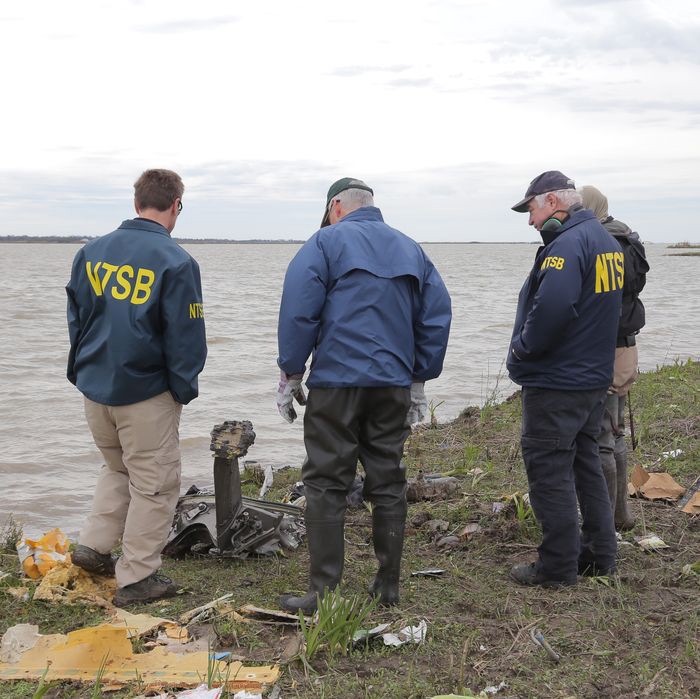 NTSB investigators examine pieces of the wreckage on shore of Trinity Bay. (New York Magazine)
NTSB investigators examine pieces of the wreckage on shore of Trinity Bay. (New York Magazine)
Finally, the NTSB examined the accidental activation of go-around mode to determine what lessons might be learned in this area. A search of records revealed no other known incidents of inadvertent go-around mode activation on the Boeing 767, either because none had occurred, or because they were not reported. But there were several such incidents on other aircraft types, including two accidents in 1994. In the first of the two accidents, a McDonnell Douglas MD-83 operating a charter flight with Air Libert Tunisia was on approach to Kajaani, Finland, when the crew accidentally activated go-around mode at an altitude of 120 feet. During their attempt to recover, they landed too far down the runway and with too much power on the engines, causing the plane to run off the end of the runway. The landing gear collapsed and the plane was substantially damaged, but none of the 171 people on board were seriously hurt. The second accident did not have such a happy ending. In April of that same year, China Airlines flight 140, an Airbus A300, was on approach to Nagoya, Japan when the first officer accidentally pressed the TOGA switch. The pilots attempted to override the autopilot and land anyway, but the autopilot fought against them, adding more nose up stabilizer trim in an attempt to get the airplane to climb. When the pilots stopped fighting the autopilot, the plane pitched up steeply, stalled, and fell straight down onto the runway, killing 264 of the 271 passengers and crew. Given the apparent rarity of the error, the fact that three serious accidents had resulted from inadvertent go-around mode activations suggested that such events were rather dangerous, and the NTSB recommended that all Boeing 767 pilots be made aware that it was possible to accidentally press the TOGA switches while holding the speed brake lever.
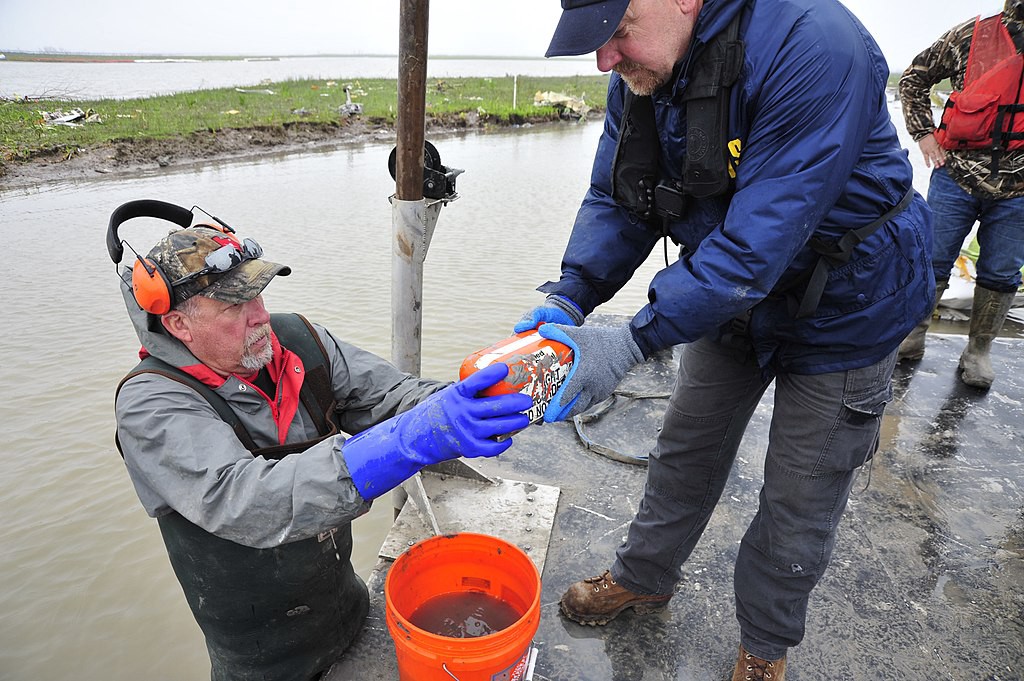 NTSB investigators recover one of the plane?s black boxes. (NTSB)
NTSB investigators recover one of the plane?s black boxes. (NTSB)
In its final report, released to the public in August 2020, the NTSB issued several more recommendations, including that PRIA records be reviewed by someone with expertise in pilot training; that the FAA implement the pilot records database as soon as possible; that an anonymized data collection system be created to help develop ?scientifically-based pilot selection strategies;? that airliners be equipped with cockpit image recorders; and that the FAA study the feasibility of developing automated ground collision avoidance systems, like those on some F-16 fighter jets, for use on large commercial aircraft. This last recommendation represented a significant new step in the NTSB?s quest to eliminate airline accidents ? if a system were developed that could automatically steer an airliner away from the ground even if the pilot is intent on diving it, far fewer airplanes would crash. Could this be the next frontier in aviation safety? The NTSB seemed to think we should at least consider the possibility.
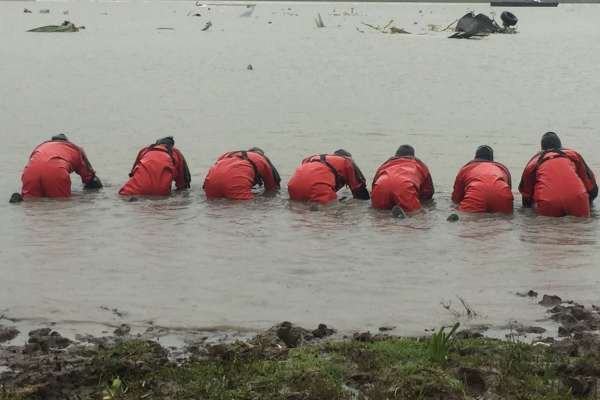 Recovery workers crawled through the shallows to feel for debris on the muddy bottom. (Houston Chronicle)
Recovery workers crawled through the shallows to feel for debris on the muddy bottom. (Houston Chronicle)
In its report, the NTSB effectively stated that Conrad Jules Aska was not smart enough to be a pilot. He lacked creativity and had little ability to keep track of rapidly developing situations. That very same limitation stifled his ability to recognize that he lacked the skill to fly airplanes safely. Atlas Air had a state-of-the-art upset recovery training program replete with strategies to maintain situational awareness and react to sudden changes in aircraft state, but it was all wasted on him. Someone should have told him to get a different job; if they had, the world would be a happier place ? three men, including Aska, would still be alive. He didn?t deserve to die, but as long as he kept flying airplanes, it was all but inevitable that he would. In fact, investigators were amazed that he didn?t crash sooner, given his complete inability to react to unexpected events.
The NTSB also stated that it did not find any evidence that Aska was hired because Atlas Air was ?scraping the bottom of the barrel? in its search for pilots. Based on what the airline thought it knew about Aska, he seemed like an excellent candidate. Even if Atlas Air wasn?t struggling to find enough pilots ? which it likely was ? it still would have hired him. What occurred was a failure to recognize a pattern of behavior. There is a certain unwillingness to let pilots wash out of training, a belief that everyone should get another chance; maybe, as the fleet captain thought, he really was just thrown off his game by the hurricane. But how many failures is too many? The truth is that before the COVID-19 pandemic there was a pilot shortage, and there probably will be again after. Airlines like Atlas Air must not bury their heads in the sand, hiring anyone with enough flight hours even if it turns out that they struggle with basic airmanship.
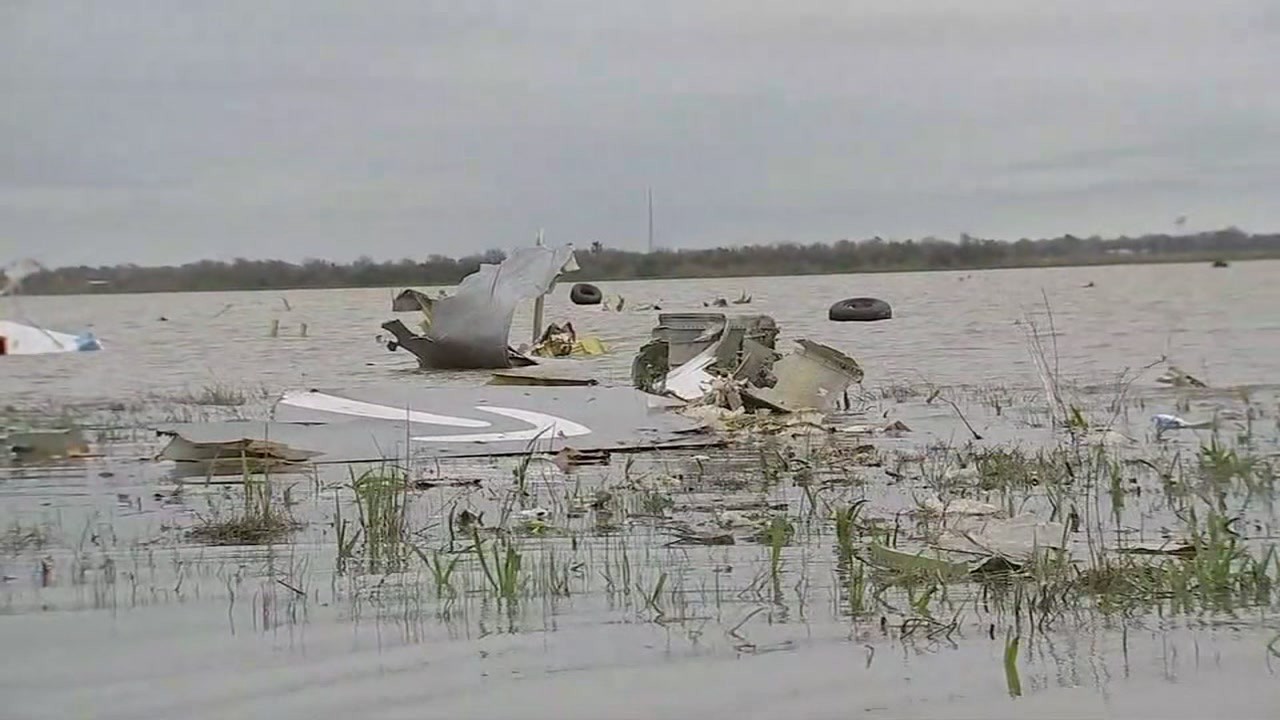 One last view of the wreckage, smile logo and all. (ABC13 Houston)
One last view of the wreckage, smile logo and all. (ABC13 Houston)
In an addendum to the report, NTSB Vice Chairman Bruce Landsberg chose to look at the big picture. If we focus on Aska?s human failings, on the legacy of his lie, we miss the real safety lessons. How many other pilots just like Conrad Jules Aska are out there right now, one accidental go-around mode activation away from disaster? The responsibility to keep them out of airline cockpits must lie with the system itself ? and Landsberg believed that that system failed. Regarding the FAA?s long-delayed implementation the pilot records database, he wrote, ?I can see no good reason as to why it should have taken that long.? Addressing industry pushback, he added, ?If you think monitoring, training or getting a solid background check on a prospective pilot candidate is expensive, try having an accident.?
______________________________________________________________
Join the discussion of this article on Reddit!
Visit r/admiralcloudberg to read over 150 similar articles.
You can also support me on Patreon!
